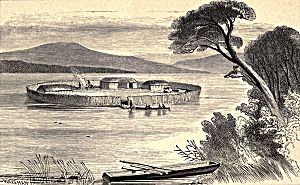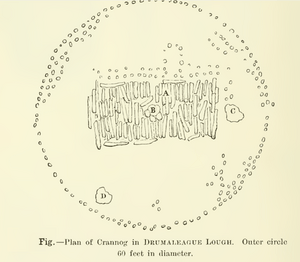Drumaleague Lough facts for kids
Quick facts for kids Drumaleague Lough |
|
|---|---|
| Coordinates | 54°0′59″N 7°59′7″W / 54.01639°N 7.98528°W |
| Lake type | Freshwater |
| Native name | Droim Dhá Liag Loch Error {{native name checker}}: parameter value is malformed (help) |
| Primary inflows | Shannon–Erne Waterway |
| Primary outflows | Shannon–Erne Waterway |
| Basin countries | Ireland |
| Surface area | 0.05 km2 (0.019 sq mi) est. |
| Max. depth | 6 m (20 ft) est. |
Drumaleague Lough is a small freshwater lake in northwest Ireland. Its name in Irish, Droim Dhá Liag Loch, means 'Lake of the ridge of the two stones'. Like many other lakes in County Leitrim, Drumaleague Lough faces threats from zebra mussels and other plants or animals that don't naturally belong there.
Contents
What's in a Name? Drumaleague Lough's Meaning
The exact story behind the name of Drumaleague Lough isn't fully known. However, its Irish name, Droim Dhá Liag Loch, means "Lake of the Ridge of two Stones" or "Pillar-Stones".
Where is Drumaleague Lough Located?
Drumaleague Lough is found about 1 kilometer (0.6 miles) south of Drumcong village. It's also 1 kilometer southwest of Lough Scur and south of Carrickaport Lough. This lake is shaped a bit like an oval.
It's quite small, covering an area of about 0.05 square kilometers (0.02 square miles). The lake is about 300 meters (984 feet) long from west to east. It measures about 170 meters (558 feet) from north to south. The deepest parts of the lake are around 6 meters (20 feet) deep. The bottom of the lake is very soft and muddy.
Drumaleague Lough is connected to other waterways. To the west, it links up with Lough Conway. To the east, it connects to Lough Scur. These connections are part of the Shannon–Erne Waterway.
Who Lives Near Drumaleague Lough?
The main village close to Drumaleague Lough is Drumcong. The lake is surrounded by different areas called townlands. These include Letterfine to the north and east, Drumaleague to the west, and Seltan (McDonald) to the south and east.
Discovering Ancient History at Drumaleague Lough
Drumaleague Lough holds secrets from a long time ago. People used to live right on the lake!
Ancient Lake Homes: Crannogs
Imagine living on an island built by people in the middle of a lake. These were called crannogs. Two of these ancient homes were found at Drumaleague Lough. They were discovered in the 1800s, around 1843 to 1852. These crannogs show us how people lived during the Middle Ages and even earlier.
Drumaleague Crannog One: A Wooden Island Home
Drumaleague Crannog number one is a great example of an old lake dwelling. Most of it was made from wood, especially Alder trees. Only the fireplace stones were different. This crannog was built with an outer ring of stakes. These stakes formed a circle about 18.3 meters (60 feet) wide.
The stakes were driven into the soft lake bottom. In some parts, there was a single row of stakes. In other parts, there were two or three rows, or even groups of stakes. This was probably to help with the layout inside the home. Because the ground was so soft, many layers of timber were used to make a strong base.
- A shows the central part, which was a platform of round logs. These logs were about 1.2 to 1.8 meters (4 to 6 feet) long. This was likely the floor of the hut.
- B was a collection of stones with signs of fire on them. This was a hearth, where people cooked and kept warm.
- C was a pile of stiff clay.
- D was the root of a large tree. It was almost completely buried in the peat. The top of the wood was shaped like a table. Underneath it, many bones were found, probably from deer and pigs.
Drumaleague Crannog Two: Another Lake Dwelling
Drumaleague Crannog number two was about 6.7 meters (22 feet) across. This crannog had a circular fence made of a single row of oak stakes (marked F, F). This fence was about 22 meters (72 feet) wide.
- The top layer (B) was made of horizontal alder logs. These logs were about 7 to 20 centimeters (3 to 8 inches) thick. They were completely soaked with water and rotten. This layer of wood was about 1 meter (3 feet) deep.
- A was a pile of stones with fire marks. Two other fireplaces were also found on this crannog.
- G was a lower layer of decayed and blackened sticks and branches. This layer went down about 1.2 meters (4 feet) but was likely even deeper.
- D, D were two piles of stones found in the lower layer.
- E was a "kitchen midden." This is like an ancient trash heap. It contained many bones from deer, pigs, and oxen. These bones were found about 1.2 meters (4 feet) below the surface.
An Ancient Canoe
An old canoe was found in the mud near the shore of Drumaleague Lough. It was made from a single oak tree trunk. The canoe was 5.5 meters (18 feet) long and 55 centimeters (22 inches) wide. It wasn't built for speed, as it was square at both ends. It also had openings or "rowlocks" cut into its sides, where oars would have rested.
When it was found, the canoe was in good condition. However, it fell apart after being exposed to the air for some time. Many ancient dug-out canoes have been found in County Leitrim. This reminds us that lakes and rivers were very important ways for people to travel, long before cars or trains existed.
Treasures from the Past: Museum Artifacts
Several old objects were found at Drumaleague Lough in the 1800s, around the same time the crannogs were discovered. These items were likely kept safe in museums, such as the Royal Irish Academy museum or the National Museum of Ireland.
- Quern Stone: A thin topstone from a "quern" was found on Drumaleague Crannog number two. A quern was an ancient tool used to grind grain into flour. This stone was smooth where it ground the grain but rough on other parts. It had a hole for a handle and a hole for the grain to go in.
- Bones: A large container of bones was also found on Drumaleague Crannog number two.
- Door-frame Piece: A part of a door-frame was discovered from one of the crannogs. It had special cuts in it for fitting other pieces of wood together.





